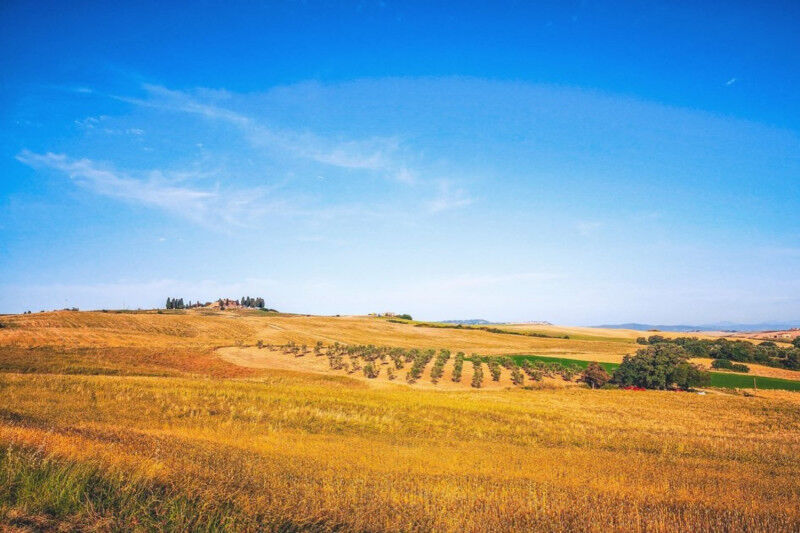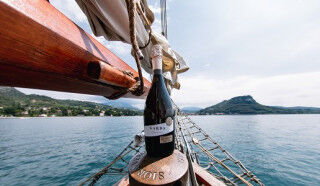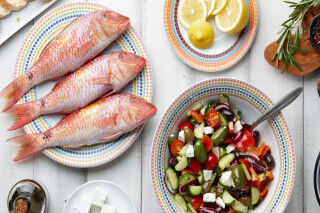ENLIGHTENED PARTNERSHIP BETWEEN MANKIND AND LAND
Val d'Orcia and Pasquale Forte: an enlightened partnership between this classic Tuscan territory with its ancient enological vitality and an engineer combining concreteness and observation with whimsy, dreams, and far-sighted vision.
Where and when are we? In the heart of Tuscany, in the mid 1990s, when Podere Petrucci changed ownership and name, transforming itself into the aptly-named Podere Forte. The felicitous word play (forte in Italian literally translates into strength, or strong) has imbued Podere Forte with the very notion of power and fortress-like solidity, concepts that lie at the very heart of the working farmhouse.
THE PODERE FORTE CONCEPT
The Podere Forte structures maintain an engaging leitfmotif across its different interests: biodynamic and organic farming are must-follow principles appearing routinely throughout its 500 hectares.
Podere Forte is divided as follows: 15 hectares dedicated to vineyards, 7.5 hectares apportioned for new vine plantings, 23 hectares allotted to olive groves, 110 hectares destined for arable lands surrounding the estate’s San Quirico d’Orcia base, 70 hectares left as untouched wooded areas, and the remaining areas devoted to a combination of pastures, breeding zones, and gardens.
Let’s take a quick peek into the estate’s wine plots. Podere Forte enjoys a solid production of varietals and wines from specific plots. Each plot naturally maintains varying yields relative to each plot’s soil composition, climatic exposure, and other natural phenomena. Renowned names like Petrucci, Guardiavigna, Petruccino, and Anfiteatro all produce top-quality grapes consequently featured as part of Podere Forte’s well-regarded Orcia wine vintages.
AGRARIAN HEART OF PODERE FORTE
Let’s shift our focus to Podere Forte’s agricultural output and projects.
Let’s begin with a look at the harmonious union between Podere Forte and the immense Senatore Cappelli grain. The result? Podere Forte’s sublime Pasta Vitaleta. The artisanal Pasta line includes the Senatore Cappelli grains cultivated and harvested directly from the Forte’s celebrated Vitaleta Chapel lands (you might recognize these landscapes from The Gladiator film, starring Russell Crowe).
The pasta line genuinely reflects the natural flavors and aromas of the Tuscan countryside, and are produced following very specific philosophies on natural, organic production methods and principles espoused by the Podere Forte structure.
Just what are Podere Forte’s fundamental guiding production principles? Let’s list them.
- the recovery of ancient traditions within the Tuscan community
- a Steinerian-based respect for the environment and surrounding lands
- maintenance of unwavering quality levels and healthfulness
These guiding principles have permitted the company to begin obtaining, in 2004, international recognition of their adherence to organic agricultural practices. 2008 brought with it official certification and recognition of the company’s organic production methods by Demeter International, the world’s largest organic certification organization.
WHAT IS THE VITALETA PASTA LABEL?
This history and experience was Podere Forte’s impetus to create the Vitaleta Pasta line, a true child of organic farming principles. Today, the pasta represents a fine standard of organic Italian farmhouse products, and is a standard-bearer within the world of Italian culture and tastes.
Podere Forte, constantly falling back on its organic farming history, has chosen a route of ancient grain and flour production. They have also opted to follow traditional farming practices, like rotational planting between grain and legumes. This approach allows the soil to regain nutrition and nitrogen despite today’s farming and agro-business proclivity towards intensive cultivation for both practicality and productivity, obviously to the detriment of both the land and quality of resulting products.
The natural attributes of Senatore Cappelli wheat made it an easy selection for Podere Forte. Thanks to the grain’s natural abundance of healthy nutrients and vitamins, the wheat also boasts a high protein value that makes this wheat an absolutely invaluable component of the Pasta Vitaleta line. Let’s not overlook its resulting amazing taste! Indeed, the ancient grains and flours produced by Podere Forte are at the heart of many a crunchy, delicious artisanal bread creation crafted by home bakers across the land.
The inclusion of semola flour is an added benefit to the Pasta Vitaleta selection. Semola adds unmistakeable color, taste, and flavor to the pasta’s structure. The stone-milling process involved in the creation of semola flour allows the pasta to ultimately maintain its organoleptic properties. What does this mean? That the pasta, once cooked, can be served at the desired “al dente” consistency, and maintain its easy-to-digest quality that naturally is part of semola-enhanced pasta selections.
What shape of Vitaleta Pasta is a home-run winner? A classic shape from the pasta line sets the path for us: the Fettuccelle variety, a traditional noodle shape, rigorously connects itself to a historic Italian approach to pasta enjoyment. Fettuccelle is a rare pasta shape that is directly linked to classic Italian first course entrées. The pasta is intrinsically connected to a Tuscan culinary nature and approach to enjoying each and every meal.












